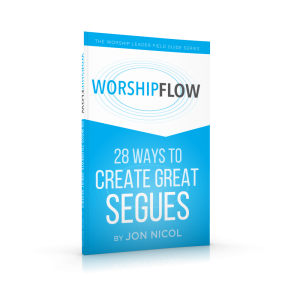Bumps
Do any of these words/phrases describe moments of your worship service?
- Bumpy
- Choppy
- Awkward Pauses
- Unintended Silence
- Confusion
Let me be clear: the goal of our worship service isn’t to have a slick and seamless, over-produced extravaganza. But we do want a service that flows well. Why? Good flow keeps people focused on worshiping God through the service elements instead of how we’re getting from one element to the next.
And here’s some really good news. Of all the challenges you have as a worship leader, this is probably one of the easier to overcome. To help you with that, I put together this short list of “rules” to help you plan worship services with great transitions.
The Five Rules Of Flow
1. Always Have A Plan
Every single time you need to connect two elements in worship, whether it’s songs, scripture, the announcements, an offering, or even the message, plan it out. Plan. It. Out.
It’s easy to think it’ll “just happen” or “I’ll just wing something.” Transitions do happen, but if they aren’t intentional, they probably don’t flow as well as we’d like.
And as for the practice of winging it (improvising—for my non-American friends), that doesn’t always deliver. Or it over-delivers and the segue goes on (and on) longer than it should.
Know how you’re getting from point A to point B. Look at how one element ends and how the next one will start. Then plan out what it takes to intentionally and meaningfully move between the two.
Oh, and write it down. Why? Because you’ll need it for the next rule:
2. Inform All Involved
You can have a great plan for a seamless segue into the offering, but if you don’t tell the ushers, they might still be sitting in their seats when you begin to pray for the offering.
And you can have a great non-talking transition planned between your opening song and the beginning of the announcement video. But if you haven’t gotten your video tech on board, there’s going to be an awkward moment. (You know, the kind where you try to Jedi-mind-trick him to start the video, while everyone’s staring at you wondering why you won’t say something.)
So when it comes to transitions and segues, make sure EVERYONE involved knows what’s happening, when it’s happening, how it’s happening and even WHY it’s happening.
If people catch the vision for the kind of moment you’re trying to create, they’ll be more apt to follow-through on the instructions you give them.
3. Brevity
Transitional elements should be short. Why? They’re the transition, not the main focus.
It’s great to read the entire chapter of Psalm 96 if that’s the main worship element. But if you’re just going for a segue from one song to the next, try saying something like,
“Psalm 96 tells us to ‘Sing to the Lord; praise his name. Each day proclaim the good news that he saves.’ Let’s proclaim the good news that he saves with this next song.”
Transition done.
And brevity is an absolute must when it’s a “talking transition.” It’s every senior pastor’s worst nightmare to have his worship leader begin to introduce a song for more than 60 seconds. Most start to get twitchy at 45 seconds.
If you feel like you need to say something, keep it brief AND follow Rule #1: Always Have a Plan. That allows you to drill into the specific thing you want to say. Not only will you save time, but your talking transition will be SO much more effective.
4. Keep It Simple
The more complex a transition is, the more likely it will fall apart.
I used to plan these elaborate segues where I’d try to get the whole band to play through a convoluted chord progression to a new key of the next song. It usually tanked.
Now I look for the simplest route from point A to point B, or point D as this example shows:
- People will likely applaud after Song A. During that, start the click and the drummer counts us in for Song B.
- As soon as the last chord of Song B ends, the keyboard player will fade in a B3 pad and the guitar starts chunking the opening chord of Song C.
- Since a few of us are switching instruments between Song C and Song D, this would be a good time to read some scripture. When the Song C ends, one of the vocalists will begin reading the scripture and the acoustic guitarist plays a soft musical bed for it in the key of Song D. The rest of us get ready for the count-in of Song D as soon as the reading is finished.
There are times when I will make a segue more complex, but it needs to serves a purpose and be a meaningful part of the worship journey.
And regardless of how simple or complex it is, I’ve learned the hard way to follow rule #5:
5. Always Practice Segues
The music team spends time rehearsing the songs. The pastor prepares for his message. The drama team practices their sketch. The media production team ensures the video plays without a hitch.
But has anyone practiced getting from song to song? Or moving from the sketch to the message? Or from the video announcement to the next song?
It may seem tedious at times, but having a run through where all those involved practice the segues.
As long as you do Rule #2 (Inform All Involved) well, some transitions can just be talked through: “As the video wrapping up, the pastor comes up to begin his message.” (My church does an “All-Hands” meeting 25 minutes before the service to cover these kinds of transitions.)
But other segues need to be practiced at least once. At the very least it’s just to have the peace of mind knowing everyone gets it. And there are times when we realize the segue we planned WON’T flow like we thought it would. It’s always good to know that before the service starts.
I could probably keep adding rules and guidelines for segues, but these five will help keep your services out of the proverbial ditch.
The “How To” On Flow

We didn’t get much time to actually talk about “how” to transition well from song to song, and element to element. If you’re wanting to dig in more, check out this affordable resource, “Worship Flow: 28 Ways to Create Great Segues.” You’ll learn how to keep your services flowing smoothly, keeping the focus on the main thing. [Click here to purchase book.]
For Discussion: I’d love to hear your thoughts about segues and transitions in worship. What works for you? What questions do you have? Do you disagree with any of this? Add your questions or comments below.
Stuck?
Learn how to level-up your team with this free video training.







